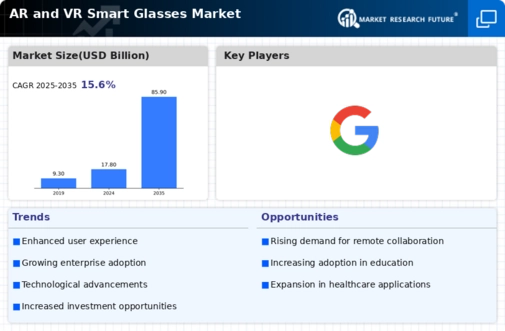Market Analysis
In-depth Analysis of AR VR Smart Glasses Market Industry Landscape
Because the technology environment is always changing, the augmented reality (AR) and virtual reality (VR) smart glasses markets are changing quickly. These smart glasses have been rather popular recently in a number of sectors, including gaming, healthcare, education, and business. The market for AR and VR smart glasses is expanding rapidly due to a number of factors, including rising consumer awareness, technological improvements, and the desire for immersive experiences. The ongoing development of AR and VR technologies is a major driver of market dynamics. Businesses are devoting significant resources to research and development in order to expand the functionality and usability of smart eyewear. This invention gives consumers a more realistic and immersive experience by enhancing gesture detection, display technology, and overall performance. Another important feature of market dynamics is the growing use of AR and VR smart glasses in corporate applications. These technologies are being used by businesses for data visualization, remote collaboration, and training. The capacity of smart glasses to superimpose digital data on the physical environment improves efficiency and production across a range of sectors. The market for AR and VR smart glasses is predicted to increase significantly in the commercial and industrial segment as a result of this trend. Another important factor influencing market dynamics is consumer acceptance. With the rising cost and accessibility of this technology, people are using AR and VR smart glasses for social media, gaming, and entertainment more and more. Because AR and VR provide game experiences a new dimension, the gaming industry in particular has been a major driver of consumer adoption. The consumer segment of the AR and VR smart glasses market is expanding at a rapid pace due to customer desire for interactive and immersive content. Furthermore, the competitive environment has a significant impact on how market dynamics are shaped. There is a greater level of rivalry and innovation in the technology sector as major corporations and startups compete for a larger portion of the market. Because of the rivalry, businesses are being forced to set themselves apart from the competitors with their product designs, features, and price points. The market for AR and VR smart glasses is growing and becoming more diverse due in part to partnerships and cooperation between content creators and tech businesses. The dynamics of the market are shaped in part by challenges. The industry is aggressively tackling difficulties including privacy concerns, technical constraints, and the requirement for standardized information. Resolving these issues is crucial to maintaining the increasing momentum in the AR and VR smart
















Leave a Comment